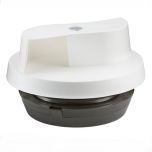Preparing Your Paperwork Before Arriving at a Shop

Too many times we get a glider for an annual and the logbook does not show up. This makes it very difficult to complete the paperwork. Many repair stations will not start the maintenance until the logbook is there and is up-to-date.
If the sailplane has a standard airworthiness certificate then you need an IA to do the annual inspection. If it has an experimental certificate then you need and A&P. The owner cannot do that inspection, unless they are the builder and have a "repairman certificate" then you can do the inspections for that sailplane. However, most of us are flying factory built experimental gliders.
Before you arrive you can get your paperwork in order. Many times there are multiple logbooks and it takes a lot of time for the mechanic to find that each AD was complied with. Having an AD summary list at the end of the logbook can save them a lot of time and you money. You could have the AD, applicable or not, date when completed, what corrective action was done, which logbook it can be found in. I am sure your mechanic will help get you started.
While you are in your list-making frame of mind I would have a similar list for SB's and Tech notes. Time-limited items can be hard to find digging through the logbooks and the maintenance manual, having a separate list for them is a good idea. Tost tow releases, seatbelts, ELT batteries, etc.
Having the required paperwork in the sailplane when it arrives is helpful too. Airworthiness, registration (current), program letter (if applicable), flight manual (if required), operating limitations (including the operating limitations paperwork required by FAR 91.319 for experimental). The operating limitations and manual will explain which placards are required.
While you are reviewing paperwork make sure your equipment list is correct, current Weight and Balance (in Europe many are weighed every 4 years or less), and maintenance manual is available.
Depending on your mechanic you might be able to remove the seat-pan and inspection covers. Lube all of the connections, vacuum, and clean everything that you can.
If you have an easy to follow list it allows the mechanic to spend time actually looking at the glider and not spending 4 hours going through 30 years of logbooks. I had a customer purchase a new to him sailplane and it took him about 10 hours to organize everything. With some shop rates exceeding $120/hr this can save you some money.




- Emergency Equipment (3)
- Checklists (12)
- Instruments (24)
- Aerotow (8)
- Cross Country (157)
- Traffic Pattern (3)
- Stalls (1)
- Landing (6)
- Control Transfer (2)
- Target Fixation (1)
- Contests (78)
- Wind (2)
- Flight Instruction (12)
- Spins (1)
- Flarm (2)
- Collision Avoidance (2)
- Preparation (19)
- Human Factors (45)
- Flight Review (3)
- FAR (5)
- Ground Handling (6)
- Wave (4)
- OLC (2)
- Maintenance (29)
- Rope Break (5)
- Weak Link (2)
- Batteries (2)
- Sailplane Trailer (3)
- Oxygen (3)
- Hypoxia (3)
- icom (1)
- transceiver (1)
- Temporary Flight Restriction (TFR) (1)
- SeeYou (3)
- Controlled Flight Into Terrain (1)
- Motor Glider (4)
- Performance Enhancements (2)
- Cruising (2)
- Pilot Relief (4)
- Communication (4)
- Buy a Sailplane (7)
- Books (3)
- Weather (6)
- Recruiting to Soaring (2)
- Center of Gravity (1)
- Ground Crew (1)
- Ground Launch (1)
- Parachute (1)
- Weather (1)
- Motorglider (3)
- Clubs (1)
- January 2025
- December 2024
- November 2024
- October 2024
- September 2024
- August 2024
- July 2024
- June 2024
- May 2024
- April 2024
- March 2024
- February 2024
- January 2024
- December 2023
- November 2023
- October 2023
- September 2023
- August 2023
- July 2023
- June 2023
- May 2023
- April 2023
- March 2023
- February 2023
- January 2023
- December 2022
- November 2022
- October 2022
- September 2022
- August 2022
- July 2022
- June 2022
- May 2022
- April 2022
- March 2022
- February 2022
- January 2022
- December 2021
- November 2021
- October 2021
- September 2021
- August 2021
- July 2021
- June 2021
- May 2021
- April 2021
- March 2021
- February 2021
- January 2021
- December 2020
- November 2020
- October 2020
- September 2020
- August 2020
- July 2020
- June 2020
- May 2020
- April 2020
- March 2020
- February 2020
- January 2020
- December 2019
- November 2019
- October 2019
- September 2019
- August 2019
- July 2019
- June 2019
- May 2019
- April 2019
- March 2019
- February 2019
- January 2019
- December 2018
- November 2018
- October 2018
- September 2018
- August 2018
- July 2018
- June 2018
- May 2018
- April 2018
- March 2018
- February 2018
- January 2018
- December 2017
- November 2017
- October 2017
- September 2017
- August 2017
- July 2017
- June 2017
- May 2017
- April 2017
- March 2017
- February 2017
- January 2017
- December 2016
- November 2016
- October 2016
- September 2016
- August 2016
- July 2016
- June 2016
- May 2016
- April 2016
- March 2016
- February 2016
- January 2016
- December 2015
- November 2015





